 Lauran Gieske is a demonstration teacher at the ELC for a classroom of 12 older toddlers (2-3-year-olds). She has her MS in Child and Family Studies from UT, where she researched cognitive development in early childhood. She has taught young children for approximately six years. She’s riding out the quarantine in her favorite reading chair with her dogs Harper and Scout.
Lauran Gieske is a demonstration teacher at the ELC for a classroom of 12 older toddlers (2-3-year-olds). She has her MS in Child and Family Studies from UT, where she researched cognitive development in early childhood. She has taught young children for approximately six years. She’s riding out the quarantine in her favorite reading chair with her dogs Harper and Scout.
As we settle into this world of quarantine and social distancing, the novelty is beginning to wear off. No one said it was any easier, but maybe you’re slowly coming off autopilot mode. Perhaps you find yourself thinking, “Alright, fine… We are going to be here awhile. It is probably time I taught my kids something or they’ll never learn anything.” Some parents from my classroom have begun to express similar thoughts. They are wondering what they can be doing to support their child’s development during this extended period away from school. So, what can you do to make sure your child is still on pace, learning, and growing appropriately?
Are you ready to be let in on a little secret? Because the thing is, you don’t have to do all that much. Set a space up, and let them play.
My teaching partner Amy and I have go-getter attitudes. We tend to get swept up in the excitement of new activity ideas and a need to get things done. That’s why this year’s motto in our older toddler classroom unofficially became, “do less.” That’s right, do less. We reminded ourselves to stop fussing over fancy, educational activities aimed at keeping the children busy and go back to basics: enriching environments and promoting play. Because at the end of the day, all young children really need to learn is quality opportunities for play.
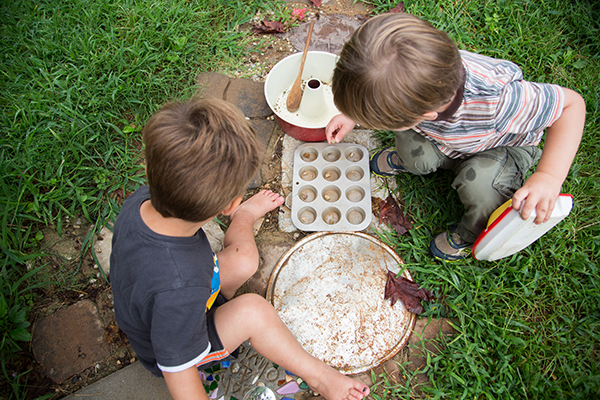 Perhaps you have heard the phrase “every child is a scientist.” From birth, children begin the process of making sense of the world around them. Like true scientists, they observe, make hypotheses, and test those hypotheses many times. Even infants drop items many times over, just to see what will happen. Soon that innate curiosity and desire to ask why will give way to even bigger questions. Children ask these questions during exploration and play. Play does not just help children develop cognitive skills, but everything from physical, to social-emotional, to language, literacy, and math. Mr. Rogers said, “Play is often talked about as if it were a relief from serious learning. But for children, play is serious learning.” We don’t need to manufacture learning or instigate development. Rather if we set up rich environments, with open materials that invite play, the inquisitiveness of children will naturally take hold.
Perhaps you have heard the phrase “every child is a scientist.” From birth, children begin the process of making sense of the world around them. Like true scientists, they observe, make hypotheses, and test those hypotheses many times. Even infants drop items many times over, just to see what will happen. Soon that innate curiosity and desire to ask why will give way to even bigger questions. Children ask these questions during exploration and play. Play does not just help children develop cognitive skills, but everything from physical, to social-emotional, to language, literacy, and math. Mr. Rogers said, “Play is often talked about as if it were a relief from serious learning. But for children, play is serious learning.” We don’t need to manufacture learning or instigate development. Rather if we set up rich environments, with open materials that invite play, the inquisitiveness of children will naturally take hold.
The Power of Open-Ended Materials
What are open-ended materials? At the core of an intriguing environment is the available materials. Open-ended materials refer to toys and items that can be used in many different ways. The use of open-ended materials is all about the process of exploration. Even if children are creating or building a product, there is no one way to do it, and all results would look different. Some classic examples of open-ended materials include blocks, paint, playdough, sand, and water. Other examples of open-ended materials include loose parts, which are materials that can be moved, carried, combined, redesigned, lined up, taken apart, and put back together in multiple ways. Loose pares could be things found around your home or in nature such as bottles, buttons, shells, sticks, acorns, etc.
materials include blocks, paint, playdough, sand, and water. Other examples of open-ended materials include loose parts, which are materials that can be moved, carried, combined, redesigned, lined up, taken apart, and put back together in multiple ways. Loose pares could be things found around your home or in nature such as bottles, buttons, shells, sticks, acorns, etc.
How do open-end materials support development?
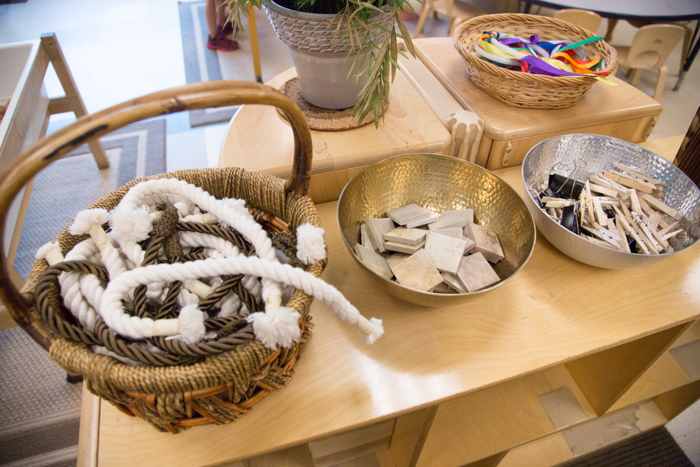
Cognitive: Because there is no one end product, the possibilities for thinking and imagination are endless. They can create, construct, and/or role-play. Not only do children use their imagination to play in their own way, but they exercise skills such as attentiveness, problem-solving, flexibility in thinking, persistence, and thinking symbolically.
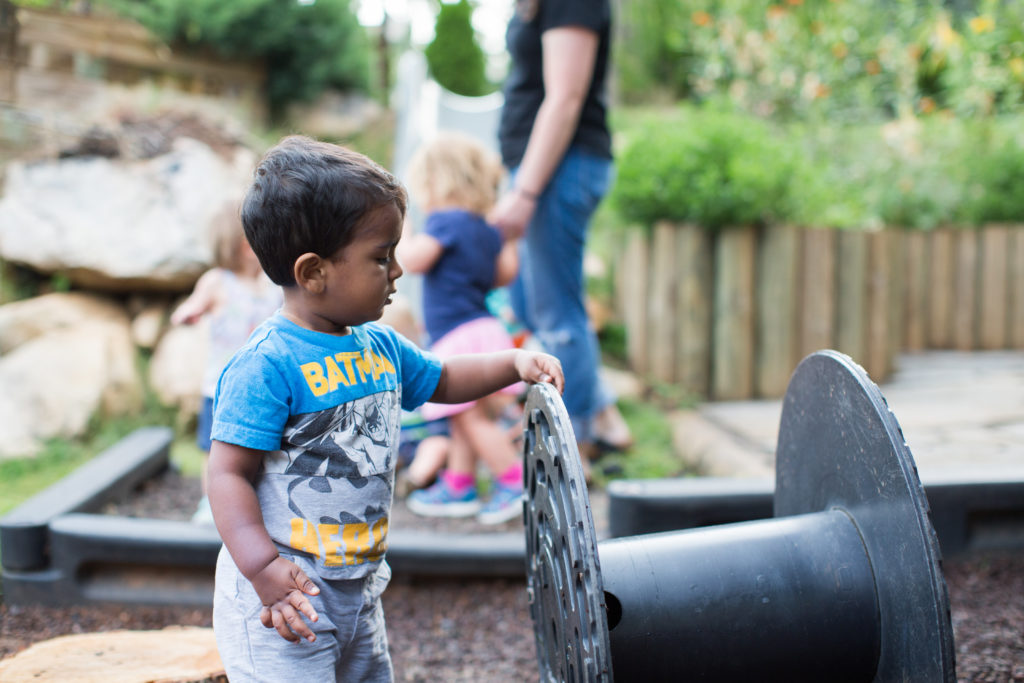
Physical: Depending on the materials used, children may stretch both gross and fine-motor skills. For example, as children move from place to place or lift large materials such as wooden blocks or cardboard boxes, they practice their gross motor skills. When they use their fingers and hands to pinch playdough, scoop sand, or handle a paintbrush they are developing fine motor skills.
 Social-Emotional: Young children are always developing social-emotional skills, particularly as they play with other people. However, they may also act out scenarios in their play that allow them to work through and reinforce the social-emotional skills they are learning. Moreover, as children explore and test their ideas, they are gaining confidence in their abilities and self-efficacy.
Social-Emotional: Young children are always developing social-emotional skills, particularly as they play with other people. However, they may also act out scenarios in their play that allow them to work through and reinforce the social-emotional skills they are learning. Moreover, as children explore and test their ideas, they are gaining confidence in their abilities and self-efficacy.
Play is Enough
So far, I have thrown the word ‘play’ around a lot. Talking about play in such a big way can easily make us feel pressured to get involved with play like you would a homeschool lesson. However, you don’t need a lesson plan, agenda, or developmental checklist for play. Play, on its own, especially with open-ended materials is enough to incite learning. Consider these things as you encourage your child’s learning through play:
 Play doesn’t have to mean doing something. Play often gets acquainted with “doing something for fun.” But it does not always look like that, especially in infants and younger toddlers. And that is okay! Older children may be more outwardly active, but there’s still value in the imagination that often looks more like daydreaming or dawdling. We have to recognize it, and most importantly not interrupt it. Educator Janet Lansbury says the secret to not interrupting is to refrain from speaking to children until they initiate eye contact.
Play doesn’t have to mean doing something. Play often gets acquainted with “doing something for fun.” But it does not always look like that, especially in infants and younger toddlers. And that is okay! Older children may be more outwardly active, but there’s still value in the imagination that often looks more like daydreaming or dawdling. We have to recognize it, and most importantly not interrupt it. Educator Janet Lansbury says the secret to not interrupting is to refrain from speaking to children until they initiate eye contact.
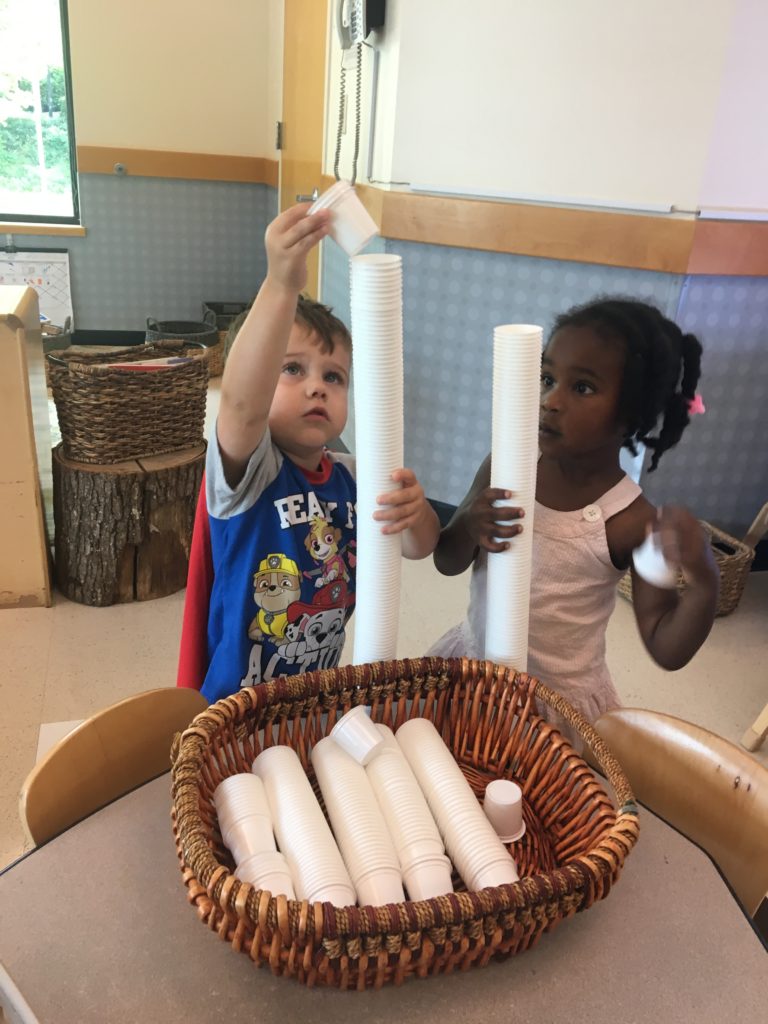 Less is More. When it comes to your direct involvement with your child’s play, sometimes less is more. We often feel pressure to entertain our children when we play with them, but that can easily become us playing for them. This can limit their learning, and even subtly communicate the way they are playing is not good enough. In our attempts to support with suggestions, we can shift the control over to the adult and interrupt play. It is so challenging, but try being more responsive while doing less. Even in the times you have designated to play with your child, it is important to leave the direction of play to children. That does not mean you can’t enjoy it and be a part of play, but watching and observing is more encouraging of children’s play than thinking or doing it for them. So be present, but try to sit in the back seat and let them drive. Or be an actor, but let them direct the production.
Less is More. When it comes to your direct involvement with your child’s play, sometimes less is more. We often feel pressure to entertain our children when we play with them, but that can easily become us playing for them. This can limit their learning, and even subtly communicate the way they are playing is not good enough. In our attempts to support with suggestions, we can shift the control over to the adult and interrupt play. It is so challenging, but try being more responsive while doing less. Even in the times you have designated to play with your child, it is important to leave the direction of play to children. That does not mean you can’t enjoy it and be a part of play, but watching and observing is more encouraging of children’s play than thinking or doing it for them. So be present, but try to sit in the back seat and let them drive. Or be an actor, but let them direct the production.
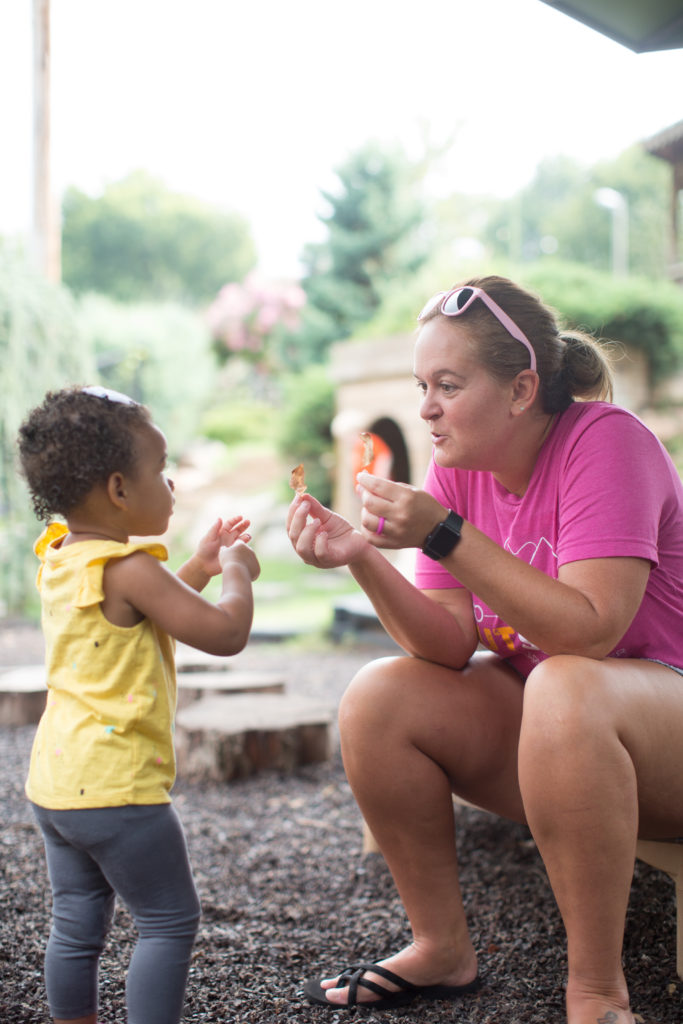 Bounce back. Sometimes the easiest way to be responsive and encourage that scientific thinking is to bounce the things children ask us back to them. If your child says, “How do you make an airplane?” Ask them, “Well how do you think you make an airplane? What does an airplane look like?” Renowned educator and president of Reggio Children, Carlina Rinaldi, said it best:
Bounce back. Sometimes the easiest way to be responsive and encourage that scientific thinking is to bounce the things children ask us back to them. If your child says, “How do you make an airplane?” Ask them, “Well how do you think you make an airplane? What does an airplane look like?” Renowned educator and president of Reggio Children, Carlina Rinaldi, said it best:
“When your child asks, ‘why is there a moon?’ Do not reply with a scientific answer. Ask him, ‘what do you think?’ He will understand that you are telling him, ‘you have your ideas and mind and your interpretation and your ideas are important to me.’ Then you and he can look for the answers, sharing the wonder, curiosity, pain- everything. It is not the answers that are important, it is the process that you and he search together.”
Remember, even if we are a few weeks in, this is still a first for everyone. Everyone worries about their children and wants to do all they can to help them learn and grow. But the world will go on, and your children will still learn and grow if you are not amazing during a world crisis. I am sure you have been told this lately, but you can’t pour from an empty cup. Take care of yourself the best you can. No need to add to your current roles. You don’t need to be the world’s best, triple threat parent/teacher/summer camp counselor (and probably trying to also be a good employee to top it off). It is just too much. All you need is play. I promise… it will be enough.
References
Lansbury, J. (2012, November 15). 7 myths that discourage independent play.
Janet Lansbury: Elevating childcare. https://www.janetlansbury.com/2012/11/7-myths-that-discourage-independent-play/
National Association for the Education of Young Children. (n.d.) Nurturing the scientist in your child. https://www.naeyc.org/our-work/families/nurturing-scientist-your-child
Rinaldi, C. and Kelly, G. [thinkersinresidence]. (2012, September 4). Introduction to Reggio Emilia. [Video]. YouTube. https://www.youtube.com/watch?v=lWf9mBJ548k&fbclid=IwAR0mv7_5a2otaGMvQ5qvnrWjpfoS91b0sAIRQbufjhAI-NUiBWelZFAgjmI
The power of open-ended materials. (n.d.) Town Square. Retrieved April 6, 2020,